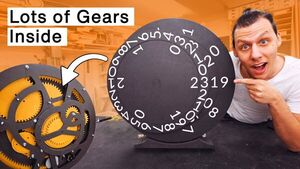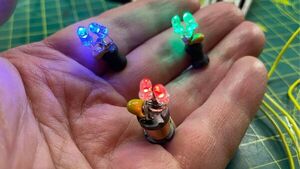2021-12-02 - Nº 344
Editorial
Esta é a Newsletter Nº 344 que se apresenta com o mesmo formato que as anteriores. Se gostar da Newsletter partilhe-a!
Todas as Newsletters encontram-se indexadas no link.
Esta Newsletter tem os seguintes tópicos:
Faz hoje anos que nascia, em 1761, o inventor francês Nicolas Louis Robert. Ele foi responsável pela invenção da máquina de papel contínua, enquanto trabalhava na Essonnes, França, fábrica de papel da família Didot de impressoras e editores. Fez o seu primeiro modelo para o processo em 1797, um protótipo em 1798, e obteve uma patente em 18 de Janeiro de 1799. O papel foi formado e transportado numa cinta móvel de gaze de arame. Didot foi no início céptico, depois encorajou Robert a melhorar a invenção, ainda imperfeita. Depois de Robert ter ficado insatisfeito com o acordo financeiro dos seus esforços, partiu e tentou montar a sua própria fábrica de papel. Quando este empreendimento falhou por falta de capital, ele vendeu os direitos de patente à Didot. A sua ideia acabou por ser desenvolvida com mais sucesso em Inglaterra pelos irmãos Fourdrinier, assistidos pelo mecânico Bryan Donkin.
Faz também hoje anos que nascia, em 1881, o físico alemão Heinrich Barkhausen. Ele descobriu o efeito Barkhausen (1919), um princípio relativo às alterações das propriedades magnéticas do metal. O seu trabalho em acústica e magnetismo levou à descoberta de que a magnetização afecta domínios inteiros de um material ferromagnético, e não apenas os átomos individuais. Descobriu que um aumento lento e suave de um campo magnético aplicado a uma peça de material ferromagnético, como o ferro, provoca a sua magnetização, não contínua mas em passos minúsculos. Com Karl Kurz, desenvolveu o oscilador Barkhausen- Kurz (1920) para frequências ultra-altas (precursor do tubo de micro-ondas), levando à compreensão do princípio da modulação da velocidade. É também conhecido por experiências em transmissões de rádio de ondas curtas.
Faz igualmente hoje anos que nascia, em 1905, o inventor germano-americano Semi Joseph Begun. Ele construiu o primeiro gravador para radiodifusão (1934), que mais tarde foi utilizado nos Jogos Olímpicos de 1936. Após a II Guerra Mundial, continuou a trabalhar em suportes de gravação magnéticos baseados no revestimento de papel e fita plástica com suspensões ferromagnéticas em pó. Begun desenvolveu o primeiro gravador de fita de consumo nos Estados Unidos sob o nome comercial Sound Mirror. Também negociou o primeiro acordo de fornecimento de fita magnética com a 3M - que se tornou uma importante linha de produtos. Também inventou o Mail-A-Voice, que gravou magneticamente num dos lados de um disco de papel para correspondência postal.
Por fim, faz hoje anos que nascia, em 1906, o engenheiro húngaro-americano Peter Carl Goldmark. Ele, enquanto trabalhava para a Columbia Broadcasting System (CBS), desenvolveu o primeiro sistema comercial de televisão a cores (1936), que utilizava um disco de três cores rotativo. Embora inicialmente aprovado pela Comissão Federal de Comunicações, foi posteriormente substituído por um sistema de cor totalmente electrónico que era compatível com conjuntos a preto e branco. A Goldmark também desenvolveu o fonógrafo LP 33-1/3 que aumentou grandemente o tempo de reprodução de discos, o que revolucionou a indústria fonográfica. Foi também pioneiro na gravação de cassetes de vídeo, e desenvolveu um sistema de digitalização utilizado pela nave espacial Lunar Orbiter em 1966 para transmitir fotografias à terra a partir da lua.
Em 1877, Louis-Paul Cailletet (1832-1913) tornou-se o primeiro a liquefazer oxigénio. Pouco tempo depois, foi também o primeiro a liquefazer azoto, hidrogénio, dióxido de azoto, monóxido de carbono, e acetileno. Cailletet percebeu que o fracasso de outros em liquefazer os gases permanentes, mesmo sob enormes pressões, foi explicado pelo conceito de temperatura crítica de Thomas Andrews. Ele conseguiu produzir oxigénio líquido ao permitir que o gás frio e comprimido se expandisse, dependendo do efeito descoberto por Joule e Thomson, que arrefeceu o gás até abaixo da sua temperatura crítica. Em experiências posteriores, liquefez nitrogénio e ar. Raoul Pictet, trabalhando de forma independente, utilizou uma técnica semelhante.
Faz hoje 50 anos que os russos conseguiam entrar na atmosfera de Marte com as naves gémeas Mars 2 e 3. "A Mars 2 sobre-corrigiu, e colocou a nave espacial num ângulo de descida demasiado inclinado para a atmosfera", diz Shindell, e o "lander" bateu com força em Marte antes mesmo de poder lançar o seu pára-quedas. "Quando atingiu a atmosfera, penso que estava a viajar algo como seis quilómetros por segundo". Marte 3, no entanto, conseguiu fazer tudo bem. Entrou na atmosfera marciana a 5,7 quilómetros por segundo, diz Shindell, mas foi capaz de travar no ar, lançar o seu pára-quedas, e tocar suavemente numa almofada de retrorocket thrust. Abriu as suas pétalas, ligou as suas câmaras, e tirou uma imagem cinzenta parcial e difusa antes de morrer, a maioria dos dados que recolheu nunca chegaram ao orbitador da Mars 3 para transmissão para a Terra.
Em 1942, o físico Enrico Fermi produz a primeira reacção nuclear em cadeia. Foi no Chicago Pile-1 (CP-1), o primeiro reactor nuclear artificial do mundo, que foi feita a primeira reacção em cadeia nuclear auto-sustentada de origem humana. Foi um esforço prodigioso. Físicos e funcionários, trabalhando 24 horas por dia, construíram uma malha de 57 camadas de metal de urânio e óxido de urânio incrustadas em blocos de grafite. Uma estrutura de madeira suportava a pilha de grafite. A reacção em cadeia fazia parte do Projecto Manhattan, um projecto secreto em tempo de guerra para desenvolver armas nucleares, que iniciou a era nuclear moderna. Esta foi uma descoberta que mudou o mundo.
Em 1982, era feito usado o primeiro coração artificial (o Jarvik-7) num paciente. Numa operação que durou mais de sete horas, o Dr. William C. DeVries substituiu o coração doente de Barney Clark. Este foi o primeiro de uma série de cinco implantes do coração artificial total do Jarvik durante os três anos seguintes. O primeiro paciente, Barney Clark de 61 anos de idade, sobreviveu durante 112 dias. Apenas outros quatro receberam o Jarvik como um coração substituto permanente. O segundo, William Schroeder, viveu 620 dias, morrendo em Agosto de 1986 aos 54 anos de idade. Outros pacientes receberam o coração artificial concebido por Robert K. Jarvik apenas como um dispositivo temporário enquanto aguardavam transplantes cardíacos.
Na Newsletter desta semana apresentamos diversas noticias, artigos científicos, projetos de maker assim como alguns videos interessantes.
 João Alves ([email protected])
João Alves ([email protected])
O conteúdo da Newsletter encontra-se sob a licença  Creative Commons Attribution-NonCommercial-ShareAlike 4.0 International License.
Creative Commons Attribution-NonCommercial-ShareAlike 4.0 International License.
Novidades da Semana
Outras Notícias

Toshiba Releases High Peak Output Current Photocouplers in Thin Packages for Driving IGBTs/MOSFETs Gates
"Toshiba Electronic Devices & Storage Corporation ("Toshiba") has introduced two photocouplers, “TLP5705H” and “TLP5702H,” housed in a thin SO6L package, for use as insulated gate drivers for small to medium capacity IGBTs/MOSFETs. Volume shipments start today. TLP5705H is Toshiba’s first product to deliver a peak output current rating of ±5.0A in a thin package (SO6L) only 2.3mm (max) high. As a result, devices such as small to medium capacity inverters and servo amplifiers that use a buffer circuit for current amplification can now drive their IGBTs/MOSFETs directly from the photocoupler, without any need of the buffer circuit. This will contribute to parts reduction and set miniaturisation. TLP5702H has a peak output current rating of ±2.5A." [...]
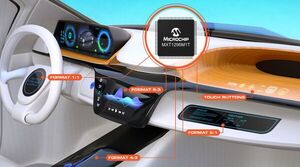
Most Versatile maXTouch Touchscreen Controller Ever Offers Extensive Screen Format Flexibility
"The MXT1296M1T provides various communication options, ISO 26262 functional safety support and flexible RF emission control As the automotive market continues to demand larger touchscreens with more flexibility in size and shape, Microchip Technology Inc. (Nasdaq: MCHP) is announcing a new maXTouch® touchscreen controller, that allows automotive designers to satisfy various and unique aspect ratios for touch displays in cars. This new offering includes additional functional safety support requested by OEMs. The MXT1296M1T can reconfigure its driving and receiving touch channels to match the exact screen format, from 1:1 to 5:1 aspect ratio, including the popular 8:3 automotive aspect ratio. This feature enables the customer to efficiently use the number of touch channels available, without the need to select a larger, more expensive touch controller. Furthermore, customers can save additional development and validation time and resources by reusing a common PCB design to support different touch sensor aspect ratios. The MXT1296M1T is an industry first to enable the sensor channel reconfiguration by parameters." [...]
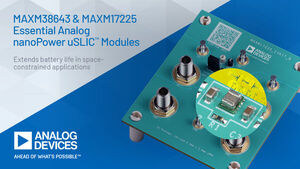
Analog Devices' Essential Analog nanoPower Modules Extend Battery Life in Space-Constrained Applications
"Designers can now extend battery life and reduce size in space-constrained internet of things (IoT) devices with two nanoPower modules with built-in inductors from Analog Devices, Inc. Both products are part of Analog Devices’ Essential Analog family of efficient power ICs. The MAXM38643 1.8V to 5.5V input, 330nA quiescent current (IQ), 600mA buck module and the MAXM17225 0.4V to 5.5V input, 300nA IQ, 1A boost module with True Shutdown™ feature the lowest IQ compared to competitive solutions and deliver more battery life. By integrating a preselected inductor, these micro system-level IC modules (uSLIC™) also accelerate time to market and are up to 37 percent smaller size compared to a standalone IC plus external inductor. Applications include space-constrained consumer products, wearables, medical drug delivery, sensors, IoT devices, as well as wired, wireless and industrial products. Battery-powered IoT devices require low IQ in system standby mode to deliver longer battery life." [...]

STMicroelectronics Reveals Next-Generation Secure Microcontroller for Biometric System-on-Card and dCVV Solutions
"STMicroelectronics (NYSE: STM), a global semiconductor leader serving customers across the spectrum of electronics applications, is facilitating advanced security for contact and contactless payment cards, ID cards, and transport ticketing with its latest-generation ST31 secure microcontroller. The ST31N600, based on ST’s 40nm eSTM technology, integrates circuitry for energy harvesting and additional connectivity used by biometric and dynamic card verification (dCVV) applications, enabling battery-free smartcards to provide enhanced user authentication in contactless and online transactions. Based on the latest-generation Arm® SecurCore™ architecture for secure microcontrollers, the ST31N600 meets EMV ISO 7816, ISO 14443, and ISO 18092 standards for contact and contactless cards and lets designers securely connect various types of peripherals to introduce value-added card features. “The ST31N600 is the starting point for great advances in smartcards, with its strong security and features that enable easy-to-use and innovative authentication mechanisms for payments,” said Laurent Degauque, Marketing Director, Secure Microcontroller Division, STMicroelectronics. “Showcasing this device at Trustech 2021, we will demonstrate secure biometric payment based on STPay-Topaz-Bio and dCVV for safe online transactions.” STPay-Topaz-Bio is a ready-to-use payment solution that adds the security of biometric cardholder authentication to the speed and convenience of contactless transactions. This Biometric System-on-Card (BSoC) solution is based on ST31N600 with an ultra-low-power STM32L4* microcontroller, both embedded in an EMV (Eurocard Mastercard Visa) module." [...]

Secure Bluetooth® Low Energy Microcontroller from onsemi Sets Industry Record for Power Efficiency
"onsemi (Nasdaq:ON), a leader in intelligent power and sensing technologies, today announced that its new, secure RSL15 wireless microcontroller (MCU) provides the industry’s lowest power consumption. Enabled with Bluetooth® Low Energy wireless connectivity, the RSL15 addresses the growing demand of connected industrial applications for security without sacrificing power consumption. To validate energy efficiency, the RSL15 was certified by the Embedded Microprocessor Benchmark Consortium (EEMBC). The organization’s ULPMark™-CoreMark benchmark program measures the energy efficiency of microcontrollers used in embedded systems while active. The RSL15 now leads its class by attaining a ‘performance’ score of 60.5. Within the ULPMark- CoreProfile benchmark, which calculates the deep sleep efficiency of MCUs, onsemi has also maintained the top two placements with the RSL10 and RSL15 respectively." [...]

Renesas Adds New Power Line Communication Modem IC Enabling High-Speed, Long Distance Communication, Expanding Practical PLC Applications
"Evaluation Kits and Tools for AC and DC Power Lines Let Developers to Immediately Evaluate Applications Supporting High-Speed Communication at Up to 1 Mbps Renesas Electronics Corporation (TSE:6723), a premier supplier of advanced semiconductor solutions, today introduced the R9A06G061 power line communication (PLC) modem IC. The R9A06G061 delivers high-speed communication at up to 1 Mbps over long distances of a kilometer or more, without the need for relays, expanding the range of practical applications for PLC. Optimized analog peripheral functions reduce the number of external components required, allowing for less expensive and more compact systems. With this combination, the new R9A06G061 is ideally suited for heating, ventilation, and air conditioning (HVAC) control, lighting system control in office buildings, and string monitoring and power conditioner control in solar power systems. Since it does not require the installation of dedicated cables, the R9A06G061 can enable low-cost system monitoring in applications such as monitoring of cellular antennas or motors in submersible pumps. While Renesas’ current R9A06G037 PLC modem IC supports the G3-PLC, PRIME and Meters and More standards and can be used to implement large-scale multi-hop networks with a mesh topology, the new R9A06G061 is designed specifically for configuring simple peer-to-peer (P2P) networks with a bus or star topology." [...]

Samsung Introduces Three New Logic Solutions To Power the Next Generation of Automobiles
"Samsung adds 5G connectivity with the Exynos Auto T5123, performance with the Exynos Auto V7 and reliability with the ASIL-B certified power management IC for automobiles Samsung Electronics, a world leader in advanced semiconductor technology, today introduced three of its latest automotive chip solutions; the Exynos Auto T5123 for 5G connectivity, the Exynos Auto V7 for comprehensive in-vehicle infotainment systems and the ASIL-B certified S2VPS01 power management IC (PMIC) for the Auto V series. “Smarter and more connected automotive technologies for enriched in-vehicle experiences including entertainment, safety and comfort are becoming critical features on the road,” said Jaehong Park, Executive Vice President of System LSI Custom SOC Business at Samsung Electronics. “With an advanced 5G modem, an AI-enhanced multi-core processor and a market-proven PMIC solution, Samsung is transfusing its expertise in mobile solutions into its automotive lineup and is positioned to expand its presence within the field.” Exynos Auto T5123: The Industry’s First 5G Connectivity Solution for Automobiles The Exynos Auto T5123 is a 3GPP Release 15 telematics control unit specifically designed to bring fast and seamless 5G connectivity in both standalone (SA) and non-standalone (NSA) mode to the next generation of connected cars. It delivers essential information to the vehicle in real-time via high-speed download of up to 5.1 gigabits per second (Gbps) and allows passengers to enjoy a host of new services such as high-definition content streaming and video calls on the go. To efficiently process large amounts of data transmitted and received through the 5G modem, the Exynos Auto T5123 supports a high speed PCIe (PCI Express) interface and a low-power high-performance LPDDR4x mobile DRAM. In addition, the unit comes with two Cortex-A55 CPU cores and a built-in Global Navigation Satellite System (GNSS) to minimize the use of external ICs and help reduce product development time." [...]

Microchip Continues Expansion of Gallium Nitride (GaN) RF Power Portfolio
"New Monolithic Microwave Integrated Circuits (MMICs) and discrete devices deliver performance levels required in 5G, satellite communication and defense applications Microchip Technology Inc. (Nasdaq: MCHP) today announced a significant expansion of its Gallium Nitride (GaN) Radio Frequency (RF) power device portfolio with new MMICs and discrete transistors that cover frequencies up to 20 gigahertz (GHz). The devices combine high power-added efficiency (PAE) and high linearity to deliver new levels of performance in applications ranging from 5G to electronic warfare, satellite communications, commercial and defense radar systems and test equipment. Like all Microchip GaN RF power products, the devices are fabricated using GaN-on-silicon carbide technology that provides the best combination of high-power density and yield, as well as high-voltage operation and longevity of more than 1 million hours at a 255o C junction temperature. They include GaN MMICs covering 2 to 18 GHz, 12 to 20 GHz, and 12 to 20 GHz with 3 dB Compression Point (P3dB) RF output power up to 20 W and efficiency up to 25%, as well as bare die and packaged GaN MMIC amplifiers for S- and X-band with up to 60% PAE, and discrete high electron mobility transistor (HEMT) devices covering DC to 14 GHz with P3dB RF output power up to 100W and maximum efficiency of 70%. “Microchip continues to invest in our family of GaN RF products to support every application at all frequencies from microwave through millimeter wavelengths, and our product portfolio includes more than 50 devices, from low-power levels to 2.2 kW,” said Leon Gross, vice president of Microchip’s discrete products business unit. “Together the products announced today span 2 to 20 GHz and are designed to meet the linearity and efficiency challenges posed by the higher-order modulation techniques employed in 5G and other wireless networks, as well as the unique needs of satellite communications and defense applications.” Microchip’s portfolio of RF semiconductors in addition to GaN devices ranges from gallium arsenide (GaAs) RF amplifiers and modules to low-noise amplifiers, front-end modules (RFFEs), varactor, Schottky, and PIN diodes, RF switches and voltage variable attenuators." [...]

Max Biaggi Shatters EV Motorcycle Speed Record With 283 MPH Run
"The MotoGP veteran took a Venturi Voxan Wattman electric motorcycle to a former NASA runway and beat his own speed record by 30 mph. Last week, legendary MotoGP rider Max Biaggi hopped on a modified Venturi Voxan Wattman electric motorcycle and took a top-secret ride down a decommissioned NASA runway in Florida—the same one where the Space Shuttle used to land. In the process, he broke 18 land-speed records for electric motorcycles, including top speed, averaging 283 mph over two runs, one in each direction. With that, Biaggi broke his own electric motorcycle speed record, set just last year, when he took a previous version of the Wattman to 253 mph. All of which begs the question: Why? "I saw that it started to be realistic, what Voxan was saying—that they could build the bike better to break the record," Biaggi told Road & Track in a one-on-one interview at the Classic Car Club Manhattan, where the electric motorcycle maker hosted a party to announce the new top-speed record." [...]

Test tanks fuelled for ESA’s Themis reusable first stage
"Recently completed tests of two propellant tanks set a first technological milestone in the ESA reusability roadmap towards the demonstration of a reusable first stage vehicle called Themis. Through the Themis programme, ESA aims to assess the economic value of reusability for Europe while investing in new technologies for potential use in ESA’s future fleet of launch vehicles. The Themis experimental approach promotes learning by hardware testing. This Agile methodology focuses on activities of greatest value and works to short timescales. To accelerate development, technologies are being tested early in the development cycle. As part of this, prime contractor ArianeGroup recently performed six tests in Vernon, France, to validate the fluidic and electrical processes and sequences for the correct operation of two test propellant tanks." [...]

Nissan unveils lunar rover prototype jointly developed with Japan Aerospace Exploration Agency
"Nissan Motor Co., Ltd. today unveiled a lunar rover prototype jointly developed with the Japan Aerospace Exploration Agency (JAXA) at its Nissan Futures event here. The JAXA Space Exploration Innovation Hub Center is conducting research on lunar rovers — a key technology for space exploration. Nissan has been working with JAXA on driving controllability of the rovers since January 2020. A lunar rover must be able to traverse the moon’s powdery, rocky and undulating terrain and be energy efficient. Furthermore, energy sources for operating vehicles in space are limited. Nissan’s research applies the motor control technology it has developed through its production of mass-market electric vehicles such as the LEAF as well as the e-4ORCE all-wheel control technology featured on the all-new Ariya electric crossover." [...]

Qualcomm Announces World’s Most Advanced Mobile Platform, the Snapdragon 8 Gen 1
"During the annual Snapdragon Tech Summit 2021, Qualcomm Technologies, Inc. introduced its latest premium 5G mobile platform, Snapdragon® 8 Gen 1. The new Snapdragon 8 leads the way into a new era of premium mobile technology equipped with cutting-edge 5G, AI, gaming, camera, and Wi-Fi and Bluetooth® technologies to transform the next generation of flagship devices. Snapdragon 8 Gen 1 will be adopted by global OEMs and brands including Black Shark, Honor, iQOO, Motorola, Nubia, OnePlus, OPPO, Realme, Redmi, SHARP, Sony Corporation, vivo, Xiaomi, and ZTE, with commercial devices expected by the end of 2021. “As the world’s most advanced mobile platform, Snapdragon is synonymous with premium Android experiences and the new Snapdragon 8 Gen 1 sets the standard for the next generation of flagship mobile devices,” said Alex Katouzian, senior vice president and general manager of mobile, compute, and infrastructure, Qualcomm Technologies, Inc. “It delivers connectivity, photography, AI, gaming, sound, and security experiences never before available in a smartphone.” Snapdragon 8 Gen 1 Key Features - Connectivity: Equipped with the 4th gen Snapdragon X65 5G Modem-RF System, the new Snapdragon 8 is the most advanced 5G mobile platform and the world’s first 5G modem-RF solution to reach 10 Gigabit download speeds. Snapdragon 8 features the Qualcomm® FastConnect™ 6900 Mobile Connectivity System supporting the fastest Wi-Fi speeds available—up to 3.6 Gbps—over Wi-Fi 6 and 6E to ensure games and apps perform smoothly, even with multiple devices on one network. - Camera: This new premium mobile platform takes smartphone photography beyond pro." [...]

SpaceX's Starlink internet satellites forced to dodge Russian anti-satellite test debris
"Debris from Russia's anti-satellite missile test last month has forced some SpaceX Starlink internet satellites to dodge in order to avoid in-orbit collisions, the company's CEO Elon Musk said Tuesday (Nov. 30). The Russian anti-satellite missile test, which shattered the defunct nearly 2-ton surveillance satellite Cosmos 1408 into thousands of pieces on Nov. 15, prompted indignation from the international space community. Companies and governmental organizations including NASA, the European Space Agency (ESA), and Earth-observation company Planet, issued statements condemning Russia's act as irresponsible and malicious. Until now, SpaceX, currently the biggest operator of satellites in the affected patch of space, remained silent. Responding to a Twitter thread discussing NASA's decision on Nov. 30 to cancel a planned spacewalk because of space debris risk, Musk admitted that his company's satellites did come close to the Russian anti-satellite test (or ASAT) debris. "We had to shift some Starlink satellite orbits to reduce [the] probability of collision," Musk said in the tweet." [...]
Ciência e Tecnologia
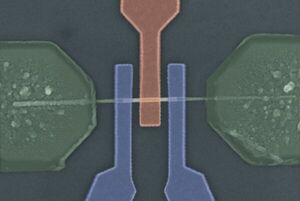
Intelligent Transistor Developed at TU Wien
"Revolutionary new electronic components can be adapted to perform very different tasks – a technology perfectly suited for artificial intelligence. Normally, computer chips consist of electronic components that always do the same thing. In the future, however, more flexibility will be possible: New types of adaptive transistors can be switched in a flash, so that they can perform different logical tasks as needed. This fundamentally changes the possibilities of chip design and opens up completely new opportunities in the field of artificial intelligence, neural networks or even logic that works with more values than just 0 and 1. In order to achieve this, scientists at TU Wien (Vienna) did not rely on the usual silicon technology, but on germanium. This was a success: The most flexible transistor in the world has now been produced using germanium." [...]
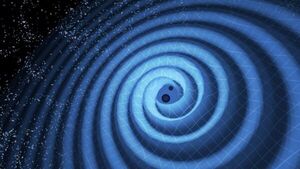
New research effort shines more light on black hole collisions
"While light can’t escape the monstrous gravity of a black hole, that hasn’t kept researchers on a team that includes UO scientists from taking a big step forward in the effort to reveal their secrets. UO researchers are a key part of LIGO, an international effort to find and understand gravitational waves. Last week, the LIGO team released the largest catalog of gravitational wave data yet, detailing 35 new collisions from their latest data collection run. Fourteen UO researchers, including nine students, contributed to the new release. “We're getting better and better,” said Robert Schofield, a research scientist who began working with the UO’s LIGO group in the late 1990s. “This data run is more sensitive than the one before it, and we could see black holes colliding further into space.” Millions of light years away, violent collisions between black holes and neutron stars send ripples through spacetime." [...]

Materials - Fresh twist on heat
"A discovery by Oak Ridge National Laboratory researchers may aid the design of materials that better manage heat. The team observed that atoms vibrating in a twisted crystal drive winding energetic waves that carry heat, like a corkscrew drives a cork from a bottle. “The structural helix puts a spin on the waves,” said ORNL’s Raphael Hermann. He and his colleagues used neutron scattering to observe wave behavior inside a twisted crystal. Then, ORNL’s Lucas Lindsay wrote rules for the wave behavior – that is, angular momentum conservation – into a model that ORNL’s Rinkle Juneja has since applied to more than a dozen materials. “New understanding of twisted systems helps us determine how heat moves in them,” Lindsay said." [...]
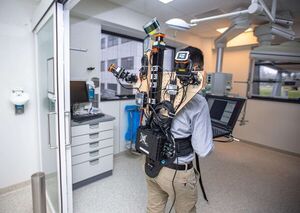
Creating 3D maps with a backpack
"In case of an emergency, up-to-date information about the inside of buildings needs to be readily available for first responders. UT researcher Samer Karam developed a wearable mapping system (the ITC-Backpack) that can map building interiors in mere minutes. Many large public buildings can get quite complex to be accurately mapped. Floor plans (2D maps) represent only important information and can become tangled in complex buildings. They are often difficult to read quickly. To make matters worse, after every reconstruction or renovation process, these maps are outdated." [...]
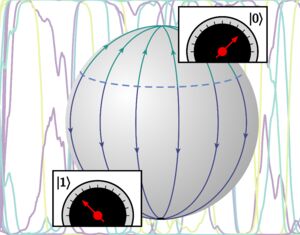
Constraining quantum measurement
"The quantum world and our everyday world are very different places. In a publication that appeared as the “Editor’s Suggestion” in Physical Review A this week, UvA physicists Jasper van Wezel and Lotte Mertens and their colleagues investigate how the act of measuring a quantum particle transforms it into an everyday object. Quantum mechanics is the theory that describes the tiniest objects in the world around us, ranging from the constituents of single atoms to small dust particles. This microscopic realm behaves remarkably differently from our everyday experience – despite the fact that all objects in our human-scale world are made of quantum particles themselves. This leads to intriguing physical questions: why are the quantum world and the macroscopic world so different, where is the dividing line between them, and what exactly happens there? Measurement problem One particular area where the distinction between quantum and classical becomes essential is when we use an everyday object to measure a quantum system." [...]
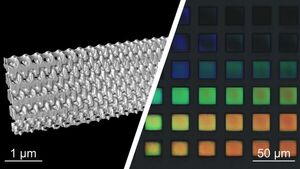
3D Laser Nanoprinters Become Compact
"Researchers of the Cluster of Excellence 3D Matter Made to Order Show How 3-dimensional Nanostructures Can Be Printed Using Compact Desktop Devices – Publication in Nature Photonics Lasers in conventional laser printers for paper printouts are very small. 3D laser printers for 3-dimensional microstructures and nanostructures, by contrast, have required big and expensive laser systems so far. Researchers of Karlsruhe Institute of Technology (KIT) and the Heidelberg University now use another process for this purpose. Two-step absorption works with inexpensive and small, blue laser diodes. As a result, much smaller printers can be used. Work is reported in Nature Photonics." [...]
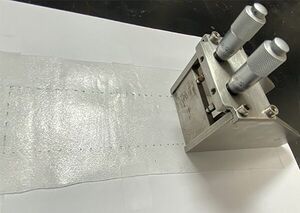
Scientists develop lead-absorbing tape to boost viability of rising star in solar power industry
"Researchers at Northern Illinois University and the U.S. Department of Energy’s (DOE) National Renewable Energy Laboratory (NREL) in Golden, Colorado, are reporting a potential breakthrough that could help speed commercialization of highly promising perovskite solar cells (PSCs) for use in solar panels. In an Oct. 28 brief communication to the journal Nature Sustainability, the scientists describe development of a cost-effective Scotch-tape-like film that can be applied to PSCs and capture 99.9% of leaked lead in the event of solar cell damage. The industry-ready film would help alleviate health and safety concerns without compromising perovskite solar-cell performance or operation, according to the research team. Testing of the lead-absorbing film included submerging damaged cells in water. “Our practical approach mitigates the potential lead-leakage to a level safer than the standard for drinking water,” said NIU Chemistry Professor Tao Xu, who co-led the research with Kai Zhu of NREL’s National Renewable Energy Laboratory. “We can easily apply our lead-absorbing materials to off-the-shelf films currently used to encapsulate silicon-based solar cells at the end of their production, so existing fabrication processes for PSCs would not be disrupted,” Xu added." [...]

Machine learning helps mathematicians make new connections
"For the first time, mathematicians have partnered with artificial intelligence to suggest and prove new mathematical theorems. The work was done in a collaboration between the University of Oxford, the University of Sydney in Australia and DeepMind, Google's artificial intelligence sister company. While computers have long been used to generate data for mathematicians, the task of identifying interesting patterns has relied mainly on the intuition of the mathematicians themselves. However, it’s now possible to generate more data than any mathematician can reasonably expect to study in a lifetime. Which is where machine learning comes in. A paper, published today in Nature, describes how DeepMind was set the task of discerning patterns and connections in the fields of knot theory and representation theory." [...]
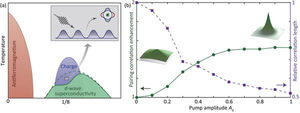
Thriving In Non-Equilibrium
"Computational studies of laser-induced non-equilibrium reveal new states of matter Equilibrium may be a hard state to achieve in our lives, but it is the standard state of nature. From the perspective of chemistry and physics, equilibrium is a bit dull – at least to Cheng-Chien Chen, assistant professor of physics at the University of Alabama at Birmingham. His research tries to engineering new states of matter and control these states by probing the possibilities of non-equilibrium. "One of our main goals is to see if, when we drive the electron system to non-equilibrium, we can stabilize new phases that are absent in equilibrium, but that can become dominant at non-equilibrium," Chen said. "This is one of the holy grails in non-equilibrium studies." Recently, with support from the National Science Foundation (NSF), Chen has been studying the effects of pump probe spectroscopy, which uses ultrashort laser pulses to excite (pump) the electrons in a sample, generating a non-equilibrium state, while a weaker beam (probe) monitors the pump-induced changes." [...]
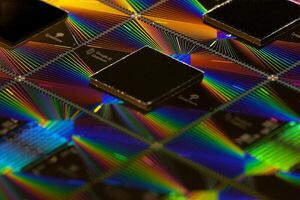
Stanford physicists help create time crystals with quantum computers
"A team of researchers including ones from Stanford and Google have created and observed a new phase of matter, popularly known as a time crystal. There is a huge global effort to engineer a computer capable of harnessing the power of quantum physics to carry out computations of unprecedented complexity. While formidable technological obstacles still stand in the way of creating such a quantum computer, today’s early prototypes are still capable of remarkable feats. For example, the creation of a new phase of matter called a “time crystal.” Just as a crystal’s structure repeats in space, a time crystal repeats in time and, importantly, does so infinitely and without any further input of energy – like a clock that runs forever without any batteries. The quest to realize this phase of matter has been a longstanding challenge in theory and experiment – one that has now finally come to fruition. In research published Nov. 30 in Nature, a team of scientists from Stanford University, Google Quantum AI, the Max Planck Institute for Physics of Complex Systems and Oxford University detail their creation of a time crystal using Google’s Sycamore quantum computing hardware." [...]

A seemingly unattainable energy transition
"Researchers have managed to address an unusual energy transition in a semiconductor. Researchers from Basel and Bochum have succeeded in addressing an apparently unattainable energy transition in an artificial atom using laser light. Making use of the so-called radiative Auger process, they were the first team to specifically excite it. In this process, an electron falls from a higher to a lower energy level and, as a result, emits its energy partly in the form of light and partly by transferring it to another electron. The artificial atoms are narrowly defined areas in semiconductors that could one day form the basis for quantum communication. The findings are described by the team from the University of Basel and Ruhr-Universität Bochum together with colleagues from Münster and Wroclaw in “Nature Communications”, published online on 12 November 2021." [...]

New process makes every atom matter for sustainable catalyst production
"Scientists have discovered a new process to break bulk metal into atoms to produce heterogeneous catalysts without any chemical waste, which will lead to new sustainable ways of making and using molecules in the most atom-efficient way. Researchers from the University of Nottingham have demonstrated that “naked” Pt atoms can be dispersed onto powder supports directly by splitting bulk metal to atoms at the record-breaking rate of four and a half thousand trillion atoms per second (4.5 x 1015 atom/s) by magnetron sputtering. The method is scalable and solvent-free and opens the door for fabrication of valuable catalyst materials where Pt atoms are supported on powder particles. The studyhas been published in the Royal Society of Chemistry’s peer-reviewed Journal of Materials Chemistry A. Catalysts enable nearly 80% of industrial chemical processes that deliver the most vital ingredients of our economy, from materials (such as polymers) and pharmaceuticals to agrochemicals including fertilisers and crop protection. The high demand for catalysts means that global supplies of many useful metals, including gold, platinum and palladium, are becoming rapidly depleted. To protect these metal supplies it is vital to utilise each and every atom to its maximum potential." [...]

Chemistry: Researchers develop novel, inexpensive catalysts enabling noble metal chemistry
"Alkynes have many uses in industry. Until now, it was assumed that gold- or platinum-based catalysts were absolutely necessary for certain chemical reactions with alkynes. Chemists at Martin Luther University Halle-Wittenberg (MLU) have now succeeded in carrying out the same reactions with considerably less expensive materials. The team reports on its work in the "Journal of the American Chemical Society". Alkynes are hydrocarbons that contain carbon-carbon triple bonds. They are among the basic building blocks of organic chemistry." [...]

Chemical researchers invent bio-petroleum for sustainable materials
"A team of researchers from the U.S. National Science Foundation Center for Sustainable Polymers based at the University of Minnesota Twin Cities have developed a chemical technology of combined fermentation and chemical refining that can produce petroleum-like liquids from renewable plants. These renewable liquids could serve as a more sustainable replacement for today’s fossil fuels used to make everyday products like plastic containers and bags, automobile parts, lubricants, and soaps. The new study by scientists at the University of California Berkeley and the University of Minnesota is published online in Nature Chemistry, a leading peer-reviewed chemistry journal by Nature Publishing Group. It has been difficult for scientists to use plants as a source for plastics because they are mostly made up of sugars which are nothing like the molecules obtained from petroleum. The key sugar in plants is glucose, which contains too much oxygen and at six carbons is too small for many important applications. In order to use plants to make new materials, both problems must be solved—the conversion process needs to strip oxygen atoms from the glucose, and molecules must be combined to make larger products." [...]

Finland's first 5-qubit quantum computer is now operational
"With this milestone, VTT and IQM take a step closer to making quantum computers manufacturable, scalable and more accessible for the world. ESPOO, Finland (November 30th, 2021) Today, VTT Technical Research Centre of Finland announced that the country’s first operational 5-qubit quantum computer is up and running. Together with the quantum computing hardware startup IQM, VTT has taken its first steps to enable the building of quantum computers that will be both scalable and easier to manufacture, allowing more companies to begin their quantum computing journey. The incredible computing performance of quantum computers makes it possible to solve problems that are beyond the capabilities of modern high-performance computers. In the future, quantum computers will be used, for instance, to accurately model viruses and drugs or used to design materials that are challenging to design with today’s technology. “The development of quantum computing will affect all industries." [...]
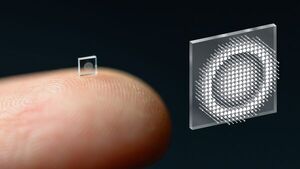
Researchers shrink camera to the size of a salt grain
"Micro-sized cameras have great potential to spot problems in the human body and enable sensing for super-small robots, but past approaches captured fuzzy, distorted images with limited fields of view. Now, researchers at Princeton University and the University of Washington have overcome these obstacles with an ultracompact camera the size of a coarse grain of salt. The new system can produce crisp, full-color images on par with a conventional compound camera lens 500,000 times larger in volume, the researchers reported in a paper published Nov. 29 in Nature Communications. Enabled by a joint design of the camera’s hardware and computational processing, the system could enable minimally invasive endoscopy with medical robots to diagnose and treat diseases, and improve imaging for other robots with size and weight constraints. Arrays of thousands of such cameras could be used for full-scene sensing, turning surfaces into cameras. While a traditional camera uses a series of curved glass or plastic lenses to bend light rays into focus, the new optical system relies on a technology called a metasurface, which can be produced much like a computer chip." [...]
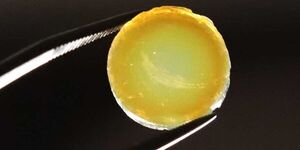
Airy and efficient
"Researchers at ETH Zurich have developed a new photocatalyst made from an aerogel that could enable more efficient hydrogen production. The key is sophisticated pretreatment of the material. Aerogels are extraordinary materials that have set Guinness World Records more than a dozen times, including as the world’s lightest solids. Professor Markus Niederberger from the Laboratory for Multifunctional Materials at ETH Zurich has been working with these special materials for some time. His lab specialises in aerogels composed of crystalline semiconductor nanoparticles. “We are the only group in the world that can produce this kind of aerogel at such high quality,” he says." [...]
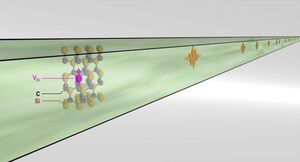
Quantum computers getting connected
"Research into superfast quantum computers is now well advanced, but it is not yet possible to connect the individual processors. An international research team with participation from the University of Stuttgart has now shown a way to scale quantum computers using nanophotonic silicon carbide structures to solve the problems. The results had been published in the journal Nature Materials. A promising route towards larger quantum computers is to orchestrate multiple task-optimised smaller systems. To dynamically connect and entangle any two systems, photonic interference emerges as a powerful method, due to its compatibility with on-chip devices and long-distance propagation in quantum networks. One of the main obstacles towards the commercialization of quantum photonics remains the nanoscale fabrication and integration of scalable quantum systems due to their notorious sensitivity to the smallest disturbances in the close environment." [...]
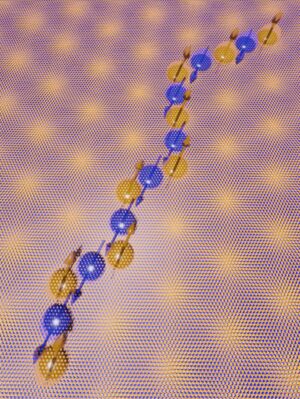
Magnets with a twist: U-M researchers engineer magnetic complexity into atomically thin magnets
"Magnets are used in so many of our everyday objects including cell phones and in the strip of a credit card or a hotel key. They even power the engine in your vacuum. And as most computers use magnets to store information, finding ever thinner magnets is key to faster, lighter electronics. Graphene, a material that is one atom thick, was discovered in 2004 and won the 2010 Nobel Prize in physics. While graphene is not magnetic itself, it triggered the interest of searching for atomically thin magnets. In 2017, scientists found an ultrathin, magnetic material just three atoms, or one atomic unit, thick." [...]
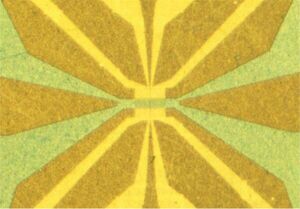
Green information technologies: Superconductivity meets Spintronics
"Superconducting coupling between two regions separated by a one micron wide ferromagnetic compound has been proved by an international team. This macroscopic quantum effect, known as Josephson effect, generates an electrical current within the ferromagnetic compound made of superconducting Cooper-pairs. Magnetic imaging of the ferromagnetic region at BESSY II has contributed to demonstrate that the spin of the electrons forming the Cooper pairs are equal. These results pave the way for low-power consumption superconducting spintronic-applications where spin-polarized currents can be protected by quantum coherence. When two superconducting regions are separated by a strip of non-superconducting material, a special quantum effect can occur, coupling both regions: The Josephson effect. If the spacer material is a half-metal ferromagnet novel implications for spintronic applications arise." [...]

Twisting elusive quantum particles
"While the number of qubits and the stability of quantum states are still limiting current quantum computing devices, there are questions where these processors are already able to leverage their enormous computing power. In collaboration with the Google Quantum AI team scientists from the Technical University of Munich (TUM) and the University of Nottingham used a quantum processor to simulate the ground state of a so-called toric code Hamiltonian – an archetypical model system in modern condensed matter physics, which was originally proposed in the context of quantum error correction. What would it be like if we lived in a flat two-dimensional world? Physicists predict that quantum mechanics would be even stranger in that case resulting in exotic particles — so-called “anyons”— that cannot exist in the three-dimensional world we live in. This unfamiliar world is not just a curiosity but may be key to unlocking quantum materials and technologies of the future. In collaboration with the Google Quantum AI team scientists from the Technical University of Munich and the University of Nottingham used a highly controllable quantum processor to simulate such states of quantum matter." [...]

Colour-changing magnifying glass gives clear view of infrared light
"By trapping light into tiny crevices of gold, researchers have coaxed molecules to convert invisible infrared into visible light, creating new low-cost detectors for sensing. Detecting light beyond the visible red range of our eyes is hard to do, because infrared light carries so little energy compared to ambient heat at room temperature. This obscures infrared light unless specialised detectors are chilled to very low temperatures, which is both expensive and energy-intensive. Now researchers led by the University of Cambridge have demonstrated a new concept in detecting infrared light, showing how to convert it into visible light, which is easily detected. In collaboration with colleagues from the UK, Spain and Belgium, the team used a single layer of molecules to absorb the mid-infrared light inside their vibrating chemical bonds. These shaking molecules can donate their energy to visible light that they encounter, ‘upconverting’ it to emissions closer to the blue end of the spectrum, which can then be detected by modern visible-light cameras." [...]

Light-powered soft robots could suck up oil spills
"A floating, robotic film designed at UC Riverside could be trained to hoover oil spills at sea or remove contaminants from drinking water. Powered by light and fueled by water, the film could be deployed indefinitely to clean remote areas where recharging by other means would prove difficult. “Our motivation was to make soft robots sustainable and able to adapt on their own to changes in the environment. If sunlight is used for power, this machine is sustainable, and won’t require additional energy sources,” said UCR chemist Zhiwei Li. “The film is also re-usable.” Researchers dubbed the film Neusbot after neustons, a category of animals that includes water striders. These insects traverse the surface of lakes and slow-moving streams with a pulsing motion, much like scientists have been able to achieve with the Neusbot, which can move on any body of water." [...]
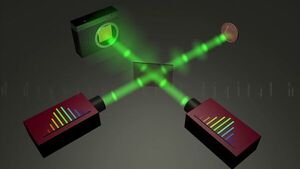
Holography meets frequency combs
"Reseachers at MPQ have just demonstrated a new technique for digital holography using two interfering frequency combs. They can now record thousands of holograms in all colours of the rainbow. Everybody has seen holograms, on a bank note, a passport or in Star Wars. Holography is a powerful technique of photography of a light field without a lens for 3D imaging and display. Now, scientists at the Max-Planck Institute of Quantum Optics move holography forward by implementing it with optical frequency combs. Thousands of holograms over all colors of the rainbow can be recorded." [...]
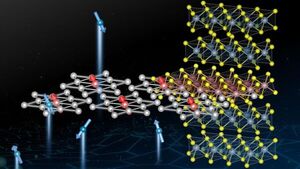
Quantum physics across dimensions: Unidirectional Kondo Scattering
"An international team led by EPFL scientists, has unveiled a unique quantum-mechanical interaction between electrons and topological defects in layered materials that has only been observed in engineered atomic thin layers. The phenomenon can be reproduced by the native defects of lab grown large crystals, making future investigation of Kondo systems and quantum electronic devices more accessible. The properties of materials that are technologically interesting often originate from defects on their atomic structure. For example, changing the optical properties of rubies with chrome inclusions has helped develop lasers, while nitrogen-vacancy in diamonds are paving the way for applications such as quantum magnetometers. Even in the metallurgical industry, atomic-scale defects like dislocation enhances the strength of forged steel. Another manifestation of atomic-scale defects is the Kondo effect, which affects a metal’s conduction properties by scattering and slowing the electrons and changing the flow of electrical current through it." [...]

New chip hides wireless messages in plain sight
"Emerging 5G wireless systems are designed to support high-bandwidth and low-latency networks connecting everything from autonomous robots to self-driving cars. But these large and complex communication networks could also pose new security concerns. Encryption methods now used to secure communications from eavesdroppers can be challenging to scale toward such high-speed and ultra-low-latency systems for 5G and beyond. This is because the very nature of encryption requires exchange of information between sender and receiver to encrypt and decrypt a message. This exchange makes the link vulnerable to attacks; it also requires computing that increases latency. Latency, the amount of time between sending instructions on a network and the arrival of the data, is a key measure for tasks like autonomous driving and industrial automation." [...]
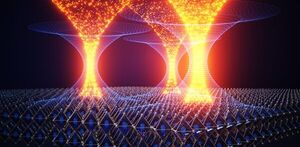
Mystery of high-performing solar cell materials revealed in stunning clarity
"Researchers have visualised, for the first time, why perovskites – materials which could replace silicon in next-generation solar cells - are seemingly so tolerant of defects in their structure. The findings, led by researchers from the University of Cambridge, are published in the journal Nature Nanotechnology. The most commonly used material for producing solar panels is crystalline silicon, but achieving efficient energy conversion requires an energy-intensive and time-consuming production process to create a highly ordered wafer structure. In the last decade, perovskite materials have emerged as promising alternatives to silicon. The lead salts used to make perovskites are much more abundant and cheaper to produce than crystalline silicon, and they can be prepared in liquid ink that is simply printed to produce a film of the material. They also show great potential for other applications, such as energy-efficient light-emitting diodes (LEDs) and X-ray detectors." [...]
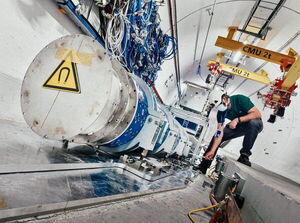
UCI-led team of physicists detects signs of neutrinos at Large Hadron Collider
"The international Forward Search Experiment team, led by physicists at the University of California, Irvine, has achieved the first-ever detection of neutrino candidates produced by the Large Hadron Collider at the CERN facility near Geneva, Switzerland. In a paper published today in the journal Physical Review D, the researchers describe how they observed six neutrino interactions during a pilot run of a compact emulsion detector installed at the LHC in 2018. “Prior to this project, no sign of neutrinos has ever been seen at a particle collider,” said co-author Jonathan Feng, UCI Distinguished Professor of physics & astronomy and co-leader of the FASER Collaboration. “This significant breakthrough is a step toward developing a deeper understanding of these elusive particles and the role they play in the universe.” He said the discovery made during the pilot gave his team two crucial pieces of information. “First, it verified that the position forward of the ATLAS interaction point at the LHC is the right location for detecting collider neutrinos,” Feng said. “Second, our efforts demonstrated the effectiveness of using an emulsion detector to observe these kinds of neutrino interactions.” The pilot instrument was made up of lead and tungsten plates alternated with layers of emulsion." [...]

Transparent electrodes without the damage
"Damage from adding electrical contacts to sensitive semiconductors can be mitigated using a buffer layer and optimized deposition. Nov 30, 2021 Crucial in the design of any semiconductor device is how to inject and extract an electrical current, and now a KAUST-led team has reviewed ways to do this without damage to the device. A basic metal-semiconductor interface can create a potential energy barrier to the efficient flow of electrons, depending on the electronic properties of the two materials. It is vital to make a careful choice of contact material and the process by which this material is deposited onto the semiconductor. These design considerations are more complicated for optoelectronic components such as light-emitting diodes (LEDs), photodetectors and solar cells because these devices require a transparent contact material to allow light in or out. Erkan Aydin and Stefaan De Wolf from the KAUST Solar Center, along with co-authors from Turkey, the Netherlands and Spain, have presented an overview for the process to stop damage occurring on devices during the creation of transparent electrodes, particularly for a technique known as sputtering." [...]

Artificial intelligence that understands object relationships
"A new machine-learning model could enable robots to understand interactions in the world in the way humans do. When humans look at a scene, they see objects and the relationships between them. On top of your desk, there might be a laptop that is sitting to the left of a phone, which is in front of a computer monitor. Many deep learning models struggle to see the world this way because they don’t understand the entangled relationships between individual objects. Without knowledge of these relationships, a robot designed to help someone in a kitchen would have difficulty following a command like “pick up the spatula that is to the left of the stove and place it on top of the cutting board.” In an effort to solve this problem, MIT researchers have developed a model that understands the underlying relationships between objects in a scene. Their model represents individual relationships one at a time, then combines these representations to describe the overall scene." [...]

New Study Shows the Largest Comet Ever Observed was Active at Near-Record Distance
"UMD astronomers discovered that comet Bernardinelli-Bernstein is among the most distant active comets from the sun, providing key information about its composition A new study by University of Maryland astronomers shows that comet Bernardinelli-Bernstein (BB), the largest comet ever discovered, was active long before previously thought, meaning the ice within it is vaporizing and forming an envelope of dust and vapor known as a coma. Only one active comet has been observed farther from the sun, and it was much smaller than comet BB. The finding will help astronomers determine what BB is made of and provide insight into conditions during the formation of our solar system. The finding was published in The Planetary Science Journal on November 29, 2021. “These observations are pushing the distances for active comets dramatically farther than we have previously known,” said Tony Farnham, a research scientist in the UMD Department of Astronomy and the lead author of the study. Knowing when a comet becomes active is key to understanding what it’s made of." [...]
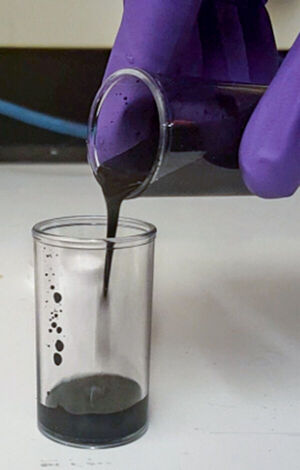
An energy-storage solution that flows like soft-serve ice cream
"Researchers make the case for a semisolid electrochemical compound as a cost-efficient, grid-scale battery backup for wind and solar power. Batteries made from an electrically conductive mixture the consistency of molasses could help solve a critical piece of the decarbonization puzzle. An interdisciplinary team from MIT has found that an electrochemical technology called a semisolid flow battery can be a cost-competitive form of energy storage and backup for variable renewable energy (VRE) sources such as wind and solar. The group’s research is described in a paper published in Joule. “The transition to clean energy requires energy storage systems of different durations for when the sun isn’t shining and the wind isn’t blowing,” says Emre Gençer, a research scientist with the MIT Energy Initiative (MITEI) and a member of the team. “Our work demonstrates that a semisolid flow battery could be a lifesaving as well as economical option when these VRE sources can’t generate power for a day or longer — in the case of natural disasters, for instance.” The rechargeable zinc-manganese dioxide (Zn-MnO2) battery the researchers created beat out other long-duration energy storage contenders." [...]

NIST Recommends Steps to Boost Resilience of U.S. Timekeeping
"The nation should bolster research and development of systems that distribute accurate time via fiber-optic cable and radio as part of the effort to back up GPS and enhance the resilience of critical infrastructure that depends on it, according to a new report by the National Institute of Standards and Technology (NIST). Many aspects of the U.S. economy and quality of life depend on accurate time, as detailed in a second, companion report. Time is a crucial underpinning of telecommunications networks, for example, as well as the power grid and stock markets, among other users. The two reports are part of NIST’s response to the Feb. 12, 2020, Executive Order 13905, Strengthening National Resilience Through Responsible Use of Positioning, Navigation, and Timing Services. The work was funded in part by the U.S. Department of Homeland Security, which commissioned NIST to “study and assess the ways in which Coordinated Universal Time (UTC) can be distributed to the public and private sector,” adding that the “performance of this distributed time should be precise enough to meet the requirements of critical infrastructure users.” An overarching concern is the need for alternatives to GPS and other global navigation satellite system (GNSS) timing signals, which are vulnerable to both accidental and deliberate interference. A previous NIST-sponsored report estimated that the combined loss of GPS position, navigation and timing services would cost the U.S. economy at least $1 billion per day." [...]
Projetos Maker
Diversos Projetos interessantes.

DIY Pen Plotter with Automatic Tool Changer | CNC Drawing Machine
"In this tutorial I will show you how I built a CNC pen plotter or a drawing machine but with one cool feature and that’s automatic tool change. In other words, the machine will be able to automatically change colors and so we can draw really cool stuff with it. Overview The construction of the machine is based on my DIY CNC Laser Engraver machine from my previous video where the goal was to make the simplest CNC machine with minimum parts possible. It uses 3 NEMA 17 stepper motors for the X, Y and the Z axis motion, and a small servo for the gripper. The brain of this CNC Pen plotter machine is an Arduino UNO board in combination with a CNC shield and three A4988 stepper drivers. The work area of fairly big, 360x280mm, and the level of details this pen plotter can output is in my opinion quite impressive too." [...]

Automatic pencil sharpener
"An automatic pencil sharpener machine that works using linear motion. You can sharpen any pencil just by pressing a button and it will take care of the rest, including gathering up all the rubbish into a container. Components - Attiny84, for the micro-controller. - Nema 17 stepper motor, to drive the linear motion. - A4988 stepper motor driver, with 100µF-1000µF capacitor across the motor power pins. - 12V power supply, with at least 3A max rated current." [...]
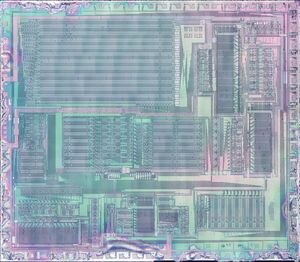
Yamaha DX7 reverse-engineering, part III: Inside the log-sine ROM
"The Yamaha DX7 digital synthesizer (1983) was the classic synthesizer for 1980s pop music. It used two custom digital chips to generate sounds with FM synthesis. In this blog post, I examine the log-sine ROM that digitally produces sine waves inside one of these chips. (This blog post jumps into the details; unless you care about the sine values specifically, my previous DX7 reverse-engineering article is probably more interesting.) I created the high-resolution die photo below by compositing over a hundred microscope photos. I removed the metal layer from the chip with acid to reveal the silicon and polysilicon wiring underneath." [...]

Arduino pov vision clock
"Hello guys in this article, I am going to tell you about the making an easy Arduino POV Clock. I have made a mini POV display using Arduino Hello guys in this article, I am going to tell you about the making an easy Arduino POV Clock. I have made a mini POV display using Arduino nano & some LEDs Here is a speciality of this project. usually, we make a POV display using a big, high-speed Dc motor because our POV circuit runs on 9v or another little bit weighty battery. Different color for better visual effect.The device is powered by a lithium ion battery through a step-up converter The propeller display is in a way like LED Matrix. It contains 19 LEDs (Light Emitting Diodes) which are arranged in the form of an 19*1 matrix (19 rows and 1 column)." [...]
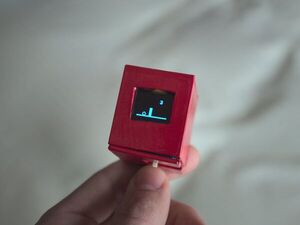
Wemos D1 - Minigame Console
"In this project we will use a Wemos D1 Mini to create a tiny Minigame-console. In this project we create a very small minigame-console that uses a gyroscope to get the inputs from the user. This way we don't have to worry about buttons and where to fit them, which makes it a lot easier to build. Because I wanted to make it portable, I added a battery shield and a small 3.7V Lipo battery. This game-console also works without the battery shield and the battery, but then it needs an external power supply over the micro USB port of the D1 mini. I used an OLED 0.66" screen that can be directly stacked onto the battery shield or the Wemos D1 mini." [...]
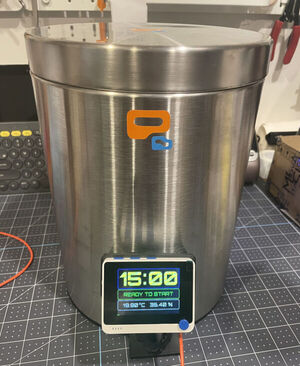
DIY 3D Resin Curing Station with Wio Terminal
"I decided to venture into the world of 3D resin printing after years of immersion using FDM (fused deposition modeling) printing. For those who are unfamiliar with this, it’s like squeezing toothpaste onto a surface. I have a Lulzbot Mini 2 and love it, but at times I want a very high quality print that I just cannot get out of FDM printing. Nor do I want to spend hours post processing. As a result, I jumped on the newly-release Elegoo Mars 3 Ultra printer (Nov 2021). It had some reviews, and apparently 4k resolution is the bomb this month (given 6/8k are just around the corner!)." [...]
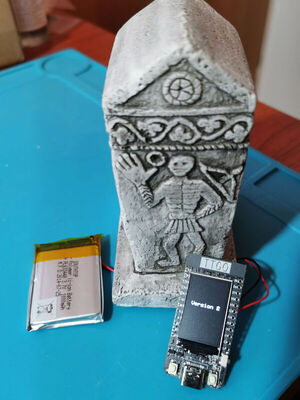
ESP32 Secure Firmware Update Over-The-Air (OTA)
"Once you deploy your IoT device, you won’t have physical access to reprogram or update it. It is critical to plan ahead and to have a secure mechanism for updating your embedded system or IoT device. Sometimes you will have the requirement to update your IoT device because of a new feature update, security issues, bugs, you did not have enough time to finish something on time and you had to ship your device and etc. Since we want to rely on existing and working software platforms, in this tutorial I will use the NGINX as a web server, “encrypted” traffic by an SSL certificate from Let’s Encrypt. I will use my test domain on lab4iot.site, I will describe everything in a step-by-step manner so that anyone can replicate and follow it. First, I will describe how to set up your domain and web server, then we will proceed with the ESP32 code." [...]

Conversation Face
"You are alone? Maybe in quarantine? Need someone to talk to? Or just a friendly listener? Or do you want to have a nice argument? Your robot needs a cute face?" [...]

Hello, my name is: a wearable name badge
"A programable and wearable electronic name badge that scrolls a name over several LED matrixes. A makerspace I'm a part of has a night that we're open to the public for people interested in joining. It's a fun community event, and it's wonderful to see people get excited about the makerspace too when we offer tours of the facilities. Typically, members wear just a piece of tape with their name written on it, but I wanted to do something a bit extra and shows off what you can do at the space. " [...]

The Arduino C64 Emulator
"An Arduino is actually powerful enough to emulate a C64. With only a few external components it outputs PAL or NTSC video and can be connected to any TV or composite input of an analog monitor. This is a further development of the Nano VIC-20 project by Jan Ostmann. The core is an emulator function for the MOS 6502/6510 CPU. This executes the 16 kilobytes of kernal and basic ROM code permanently stored in the Arduino's flash memory. Since the Uno/Nano has only 2k RAM, which is almost used up by the video RAM and the system itself, the 1k EEPROM there is also used as RAM." [...]
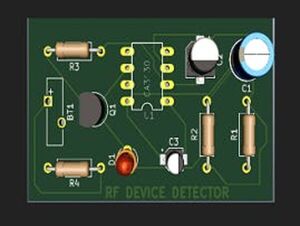
RF Transmitting Device detector
"There is no need to check manually mobile phones in the exams hall when you have a smartphone detector in your pocket. Motivation behind the project Nowadays students have become smart enough that they can bring their mobile phones to the exams hall where they are strictly not allowed to use mobiles. Sometimes teachers can find phones but when there is a large number of students it is hard to check every student manually. This mobile phone detector can easily detect any RF transmitting device. This is portable, easy to carry, and accurate in detecting the presence of mobile phones. Working on the project The MOSFET OP amplifier CA3130 used in this project is used to detect mobile phones in restricted areas." [...]
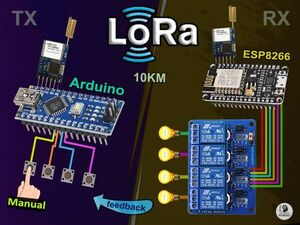
LoRa Project With ESP8266 Arduino Control Relay
"In this Lora project, I have shown how to make the LoRa Arduino ESP8266 control relay using the RYLR896 LoRa module with real-time feedback. Required component for this Transmitter circuit: - REYAX RYLR896 Lora Module - Arduino Nano - 220-ohm Resistor - 4.7k Resistor - 10k Resistor - 5-mm LED 3no - Push buttons 4no Required component for this Receiver circuit: - REYAX RYLR896 Lora Module - ESP8266 NodeMCU - 5v 4-channel Relay Module - 4.7k Resistor - 10k Resistor" [...]

How to Create a Clock Using Arduino, DS3231 RTC Module and OLED Display
"I have made a couple of clock project in the past. I have always used DS1306 module to do it. I received the backlash from my viewers. They questioned why I would use that particuler RTC module labeling it as not relaible. Now that I think of it I had issues with those RTC modules being off by a minute or two after operating for a week. Everyone pointed to DS3231 as a much more precise module." [...]
Secção Videos
Videos interessantes.
That's all Folks!




